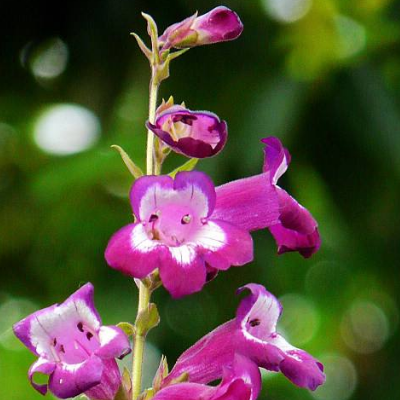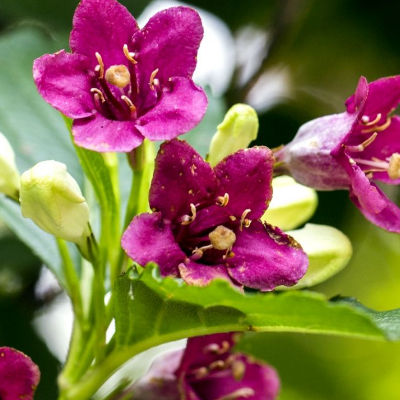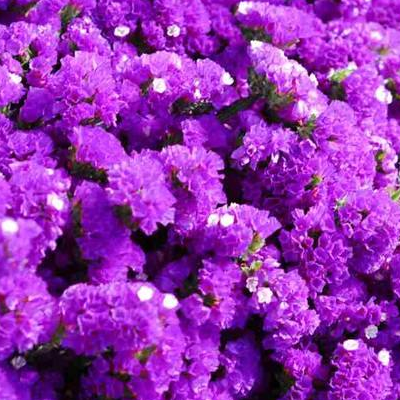What are the matters needing attention in the flowering maintenance of fishing bell willow?
The bell willow, this kind of plant blooms when is really super beautiful, this flowering time is when? What are the precautions for the maintenance of bell willow flowering:

Flowering of the bell willow:
The flowering period of bell willow can be divided into two stages, one in spring and the other in summer and autumn. The flowering period of Salix angustifolia is from April to June, and the other period is from July to October.
When the bell willow blooms, it usually opens into a large panic-shaped inflorescence with small flowers on it, presenting a bell-shaped shape. Fishing bell willow color or rich, common purple, purple, and rose red, white. Blue and pink, etc.
Notes on the flowering of bell willow:
During the growth period and before and after flowering, attention should be paid to supplementing nutrients. Timely fertilization, especially phosphorus and potassium fertilizer, can promote its flowers to be large and colorful. After the bell willow blooms, it needs to pay attention to cold protection to make it safe to winter. Potted bell willow can be pruned from late September to early October, cutting off the dead branches of the upper part of the whole plant, and then burying it safely in the soil for winter. The ground planting generally needs to cut off the part on the ground and call the antifreeze water for winter.
The flowering period and precautions of the bell willow are introduced here. Don't hurry to try breeding the bell willow.
Notes on the flowering of the bell willow
During the growth period and before and after flowering, pay attention to regularly supplement nutrients to the plant, which requires you to fertilize the plant in time, especially phosphorus and potassium fertilizers, which can promote the plant's flowers to bloom big and bright. After flowering, the plant needs to be kept warm so that it can survive the winter safely.
Potted bell willow can be pruned from late September to early October, cutting off the dead branches of the upper part of the whole plant, and then burying it safely in the soil for winter. In general, it is necessary to cut off the parts on the ground and pour antifreeze water for winter.
If you want to see the flowers of the bell willow, you must control the time well. If you miss the flowering time of the plant, you will have made a wasted trip. Also, if you have a flowering bell willow in your home, you must take good care of it during this period and strive to make its flowers bloom more brightly.
Introduction to the cultivation method of the bell willow and its several breeding methods
It was May, and now it was the flowering season of the bell willow. When it comes to fishing bell willow, you may not be familiar with it. It is a beautiful flowering plant with rich colors. Its flowers are very small, flower-shaped a bit like morning glory do! Today, I will take you to understand the breeding method of fishing bell willow.
breeding method
1. soil
Salix can't adapt to acid soil, it can grow healthily in neutral or alkaline soil, and it is best to have excellent drainage performance, good permeability and calcareous fertile sandy soil.
2. light and temperature
The bell willow likes light and grows healthiest in an environment with sufficient light, humid air and good ventilation. However, the bell willow is not heat-resistant, so do not properly shade in summer to prevent direct sunlight from damaging the flowers and leaves of the bell willow.
3. water and fertilizer management
The soil for planting the bell willow must have good drainage. If potted plants are planted, flowerpots with holes in the bottom should be selected. Some gravel under the pots can prevent the soil from being too wet and causing the roots of the bell willow to rot. Pay attention to timely fertilization before and after flowering, which can make its flowers big and colorful. Cold protection measures should be taken after flowering to help it survive the winter smoothly.
4. pest control
There will be a large number of axillary buds and adventitious buds clustered, internodes become shorter, leaves become yellow and smaller, produce bright veins, winter twigs do not fall off as nests, serious diseased plants die in the same year, and light ones will die a few years later. The disease is severe in July and August every year. In spring, peeling the diseased branches in a ring can prevent the pathogen from transferring and spreading to other parts and achieve the control effect.
5. How to spend summer safely
The bell willow is cold-resistant, likes cool, moist environment, suitable for growing in the north. So what about the southern friends who love the bell willow deeply? As long as you properly shade, do a good job of ventilation measures, less fertilization and less watering, fishing bell willow or can safely spend the summer. Southern small partners also rest assured of breeding it!
propagation method
1. sowing method
Sowing germination slow, multi-autumn sowing, temperature above 18~21℃ to germinate. During the growing period, topdressing, chicken manure or compound fertilizer can be applied once every half month. Most of the seeds are harvested in autumn and can be sown. The seedling stage is delicate, and attention needs to be paid to keeping the substrate moist, often watering or soaking the pot. Sowing propagation is easy to occur variation, so many excellent varieties generally do not use this method.
2. cutting propagation
Fine varieties can be propagated by cuttings in autumn, and cuttings can be carried out in October. Select the strong post-flowering shoots, cut them into cuttings about 10cm long, disinfect the cut parts with carbendazim or captan, and insert them into sterilized plain sand cuttings or collapsed pots. Keep humidity and shade properly, about 30 days can take root. Rooted plants can be planted in pots. If you plant flower beds, you can plant them on the ground in March to April after thawing in the following year.
3. Plant division propagation
The bell willow is mostly selected in spring. In a few days after the mother plant just exposed new buds, dig up the mother plant soil lump or take off the pot, determine the new plant according to the bud, cut the new plant from the mother plant with a knife, and directly transplant. After planting, irrigation water can quickly expand the root system and grow into considerable plants.
The above is the breeding method and breeding method of the fishing bell willow that I have sorted out. I hope it can help the majority of flower friends. Please also continue to pay attention to the fleshy flower beds and learn more about flower maintenance.
- Prev

How does the sea cucumber grow in winter?
Hylocereus, this is a lot of people like to cultivate, this Hylocereus bloom or quite good-looking, Hylocereus cultivation method is what kind of? Hyacinth winter deciduous Mody: Hyacinth breeding methods: soil selection, selection of good drainage, good permeability of sandy loam as a cultivation substrate
- Next

Is the planting method of Buxue grass also called forget-me-not?
Buxue grass, this is a kind of plant, this blood grass is a lot of people like breeding, what is the planting method of this blood grass? Is Buxue grass also called forget-me-not: the planting method of Buxue grass: the choice of soil fertilizer, Buxue grass needs soft soil.
Related
- Fuxing push coffee new agricultural production and marketing class: lack of small-scale processing plants
- Jujube rice field leisure farm deep ploughing Yilan for five years to create a space for organic food and play
- Nongyu Farm-A trial of organic papaya for brave women with advanced technology
- Four points for attention in the prevention and control of diseases and insect pests of edible fungi
- How to add nutrient solution to Edible Fungi
- Is there any good way to control edible fungus mites?
- Open Inoculation Technology of Edible Fungi
- Is there any clever way to use fertilizer for edible fungus in winter?
- What agents are used to kill the pathogens of edible fungi in the mushroom shed?
- Rapid drying of Edible Fungi

